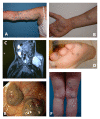Author Notes
Center for Vascular Anomalies, Cliniques Universitaires St Luc, Brussels, Belgium
Coordinator: Prof Laurence M Boon, plastic surgeon
VASCERN-VASCA
Co-Chairs: Profs Miikka Vikkula and Laurence M Boon
Prof Vikkula, de Duve Institute, Clinical Geneticist, WELBIO Investigator at the WEL Research Institute
Google Scholar profile (M Vikkula)
Google Scholar profile (L Boon)
Prof Miikka Vikkula, MD, PhD (1992-1993, Helsinki, Finland), is a professor of genetics who became interested in vascular anomalies during his postdoctoral training at Harvard Medical School (1993-1997). Together with his wife, Prof Laurence M Boon, MD, PhD, Coordinator of the Center for Vascular Anomalies (Brussels), he has unraveled some key concepts in the pathophysiology of vascular anomalies. The couple discovered TIE2 for familial venous malformation (in 1996), as well as many other genes since, and have demonstrated "second hits" in multiple cutaneous and mucosal venous malformations (VMCM) and glomuvenous malformations, identified novel clinical entities (such as CM-AVM1 and 2) and made the pivotal demonstration that somatic mutations explain sporadically occurring vascular anomalies (in 2009). With collaborative efforts to generate the first ever animal model for venous malformations, and the proof of concept for treatment with rapamycin, a small molecular inhibitor of VM, the couple is at the forefront of developing novel targeted therapies based on genetic and pathophysiologic discoveries. Clinical trials are now being conducted with various molecules in some countries. Moreover, off-label use of sirolimus has become a reference treatment for VM. Profs Boon and Vikkula are well-known internationally as major contributors to the understanding of the molecular basis of vascular anomalies, with >200 peer-reviewed publications, >50 reviews and chapters in major medical textbooks, and with >14,000 citations and an H-index of 59 (Google Scholar) for Prof Boon, and >23,000 citations and an H-index of 77 (Google Scholar) for Prof Vikkula. They have received numerous honors such as the Inbev-Baillet Latour Clinical Prize and, for Prof Vikkula, the 1st Generet Award 1 MEUR (in 2019). Prof Vikkula is also the recipient of the Earl Benditt Award 2023 by NAVBO (North American Vascular Biology Organization). They are both Full Members of the Royal Belgian Academy of Medicine. Prof Vikkula is also a WELBIO Investigator at the WEL Research Institute.
Dr Emmanuel Seront, MD, PhD (2013) is a medical oncologist who focused his PhD thesis on the mTOR signaling pathway in urologic cancers. He has since worked in close collaboration with the Boon-Vikkula team in order to conduct the large Phase III clinical trial (VASE) using sirolimus in slow-flow vascular malformations. Other trials evaluating new targeted agents are currently ongoing, based on genetic and pathophysiologic discoveries. Dr Seront is a member of the multidisciplinary Center for Vascular Anomalies, Brussels, Belgium (a VASCERN-VASCA reference center) and many oncologic societies (Belgian Society of Medical Oncology, European Society of Medical Oncology, American Society of Clinical Oncology).
All authors are actively involved in clinical research regarding individuals with TEK-related VMCM. They would be happy to communicate with persons who have any questions regarding diagnosis of TEK-related VMCM or other considerations.
Contact Prof Miikka Vikkula to inquire about TEK variants of uncertain significance.
All authors are also interested in hearing from clinicians treating families affected by VMCM in whom no causative variant has been identified through molecular genetic testing of the genes known to be involved in this group of disorders.
Acknowledgments
All three authors of this publication are members of the Vascular Anomaly Working Group (VASCA) of the European Reference Network for Rare Multisystemic Vascular Diseases (VASCERN), Project ID: 769036.
We are grateful to all the affected individuals and their family members for their invaluable participation during the years of our research studies. Our studies have been financially supported by the Fonds de la Recherche Scientifique – FNRS Grants, most recently by T.0026.14 and T.0247.19 (to MV), T.0146.16 and P.C013.20 (to LMB), the Fund Generet managed by the King Baudouin Foundation (Grant 2018-J1810250-211305) (to MV), and by the Walloon Region through the FRFS-WELBIO strategic research program (WELBIO-CR-2019C-06) (to MV). Our work has also been funded by the MSCA-ITN network VA Cure No 814316 (to MV), the Lymphatic Malformation Institute (LMI), USA (to MV), and the Leducq Foundation Networks of Excellence Program grant "ReVAMP" (LFCR Grant 21CVD03). Our groups have also been funded by the Swiss National Science Foundation under the Sinergia project no. CRSII5_193694 (LB/MV), and by a continued Pierre M fellowship. We also thank the National Lottery, Belgium, and the Foundation against Cancer (2010-101), Belgium, for their support to the Genomics Platform of Université catholique de Louvain and de Duve Institute, as well as the Fonds de la Recherche Scientifique – FNRS Eguipment Grant U.N035.17 for the "Big Data Analysis Cluster for NGS at UCLouvain."



